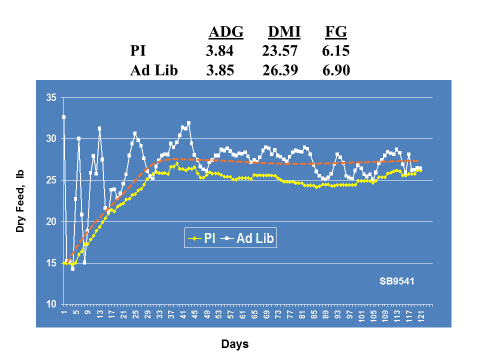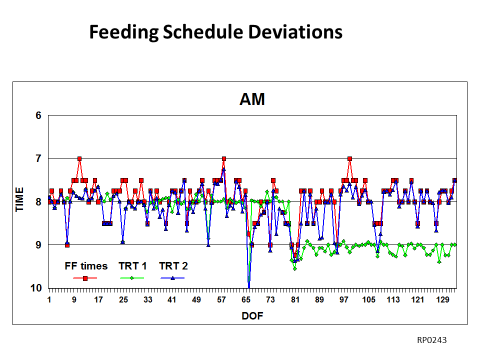Feed & Bunk Management for Cattle Feeding
‘Many an experienced stockman can carry steers thru the fattening period without getting them once “off feed,” but yet cannot well describe to others just why he is so successful.’ Feeds and Feeding - Henry and Morrison, 1928.
When we feed cattle the goal is to control the amount of variation we have within a feeding system: We want to deliver the same feed, at the same time, with the same quality, and in the same quantity every day! We want to optimize consistency in the way we do these things to improve cattle health and ultimately profitability.
Bunk management is the most inexpensive way to improve feed to gain, and allows cattle feeders the ability to deliver the same quantity and quality of feed every day to cattle minimizing variation. Managing bunks ultimately manages nutrient and energy intake, as well as ingestion of vitamins, minerals, and feed additives of cattle diets. Our goal when feeding cattle is to get a consistent and stable fermentation in the rumen, which improves the efficiency of any diet. The goal is not to maximize intake, but rather to minimize satiety. When this is the goal we want to “prescribe” the feed delivered or manage bunks, not use an ad libitum feed delivery. Prescribed feeding improves live animal performance compared to ad libitum feeding (Figure 1) and it is not cost prohibitive to implement.
Figure 1.

PI-prescribed Intake
Ad Lib-Ad libitum intake
There are minimal tools needed for bunk management: a bunk sheet with at least 4 days of previous feed deliveries and the corresponding bunk/cattle scores (which you can develop a system that works best for your operation), a spreadsheet or graph paper to track intakes, an observant and responsive personality to monitor cattle behavior, and you must be honest with yourself about the calls you make. These bunk management records or the feed calls should include previous feed deliveries, bunk & cattle scores, any feed schedule changes, and any batch changes at the mixer. To be a successful bunk reader/manager you have to know where the cattle have been: feed leftover, fines or roughages left, loose stools, how fast cattle clean up the feed, which is why records are important to an operation.
Reading bunks requires an individual to be very observant not just at the bunk, but within a pen of cattle too. What are the cattle doing, what is their interest at the bunk, how do their stools look, what is the temperature like, how many days on feed are they? These are all questions to ask yourself just about the cattle. And what do the bunks look like: Is there a uniform feed mix and delivery, are their fines or roughages left because cattle are sorting, what is the apron condition like (do cattle have to work to get to the bunk?), are the bunks dirty or wet? These are all questions to take into account when reading bunks. You also want to pay attention to how quickly cattle are cleaning up the feed delivered, which requires another trip past the bunk. If you feed in the morning and cattle have the bunk slicked by 1 pm, you are behind the cattle and holding them back on intake. We ultimately want to get cattle eating behavior in line: minimize the potential for binge feeding or getting behind the cattle. We also want to minimize feed sorting and avoid allowing cattle to develop aggressive feeding behaviors. This will keep cattle on feed and improve live cattle performance.
In addition to bunk management, the long time standard has been feeding within 15 minutes of the same time every day. “Cattle should be fed at certain hours and in the same way. This cannot be varied 15 minutes without some detriment to the cattle. The extent of insult will depend upon the frequency and extent of irregularity….” Mumford (1908). Research of feeding at random times shows the adverse effects on live cattle performance (Figure 2 & 3). An easy way to see how you are doing is record on your feed sheet what time you feed every day.
Figure 2.

FF-no scheduled feeding time
TRT 1- Regularly scheduled feeding time
TRT 2- No scheduled feeding time
Figure 3.

Records are an integral part of cattle feeding. This becomes very evident when trying to minimize variation within an operation. The challenge is not only capturing the records needed, like intake and what is actually being fed, but then evaluating variation within those records to make improvements in the operation. Similar to manufacturing processes, quality control can be used in a few different areas of the feedlot to target key sources of variation. These areas include ingredient composition (same quality), feed batching & mixing processes (same feed), feed calls & feed deliveries (same quantity), and schedules (same time). Minimizing variation in these areas will improve your operations profitability and ability to feed cattle.
Anna Taylor
Animal Scientist


